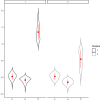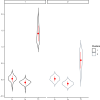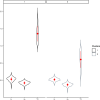Community mobility in the European regions during COVID-19 pandemic: A partitioning around medoids with noise cluster based on space-time autoregressive models
- PMID: 35722170
- PMCID: PMC9193889
- DOI: 10.1016/j.spasta.2021.100531
Community mobility in the European regions during COVID-19 pandemic: A partitioning around medoids with noise cluster based on space-time autoregressive models
Abstract
In this paper we propose a robust fuzzy clustering model, the STAR-based Fuzzy C-Medoids Clustering model with Noise Cluster, to define territorial partitions of the European regions (NUTS2) according to the workplaces mobility trends for places of work provided by Google with reference to the whole COVID-19 pandemic period. The clustering model takes into account both temporal and spatial information by means of the autoregressive temporal and spatial coefficients of the STAR model. The proposed clustering model through the noise cluster is capable of neutralizing the negative effects of noisy data. The main empirical results regard the expected direct relationship between the Community mobility trend and the lockdown periods, and a clear spatial interaction effect among neighboring regions.
Keywords: COVID-19 outbreak; Fuzzy C-medoids clustering; Google COVID-19 community mobility report; NUTS 2; Robust clustering; STAR model.
© 2021 Elsevier B.V. All rights reserved.
Figures




















Similar articles
-
Spatial robust fuzzy clustering of COVID 19 time series based on B-splines.Spat Stat. 2022 Jun;49:100518. doi: 10.1016/j.spasta.2021.100518. Epub 2021 May 15. Spat Stat. 2022. PMID: 34026473 Free PMC article.
-
Lockdown for COVID-19 and its impact on community mobility in India: An analysis of the COVID-19 Community Mobility Reports, 2020.Child Youth Serv Rev. 2020 Sep;116:105160. doi: 10.1016/j.childyouth.2020.105160. Epub 2020 Jun 12. Child Youth Serv Rev. 2020. PMID: 32834269 Free PMC article.
-
A Fast Weighted Fuzzy C-Medoids Clustering for Time Series Data Based on P-Splines.Sensors (Basel). 2022 Aug 17;22(16):6163. doi: 10.3390/s22166163. Sensors (Basel). 2022. PMID: 36015930 Free PMC article.
-
Measuring Competitiveness at NUTS3 Level and Territorial Partitioning of the Italian Provinces.Soc Indic Res. 2022 Oct 6:1-43. doi: 10.1007/s11205-021-02836-y. Online ahead of print. Soc Indic Res. 2022. PMID: 36245938 Free PMC article.
-
KL Divergence-Based Fuzzy Cluster Ensemble for Image Segmentation.Entropy (Basel). 2018 Apr 12;20(4):273. doi: 10.3390/e20040273. Entropy (Basel). 2018. PMID: 33265364 Free PMC article.
Cited by
-
Hierarchical Bayesian spatio-temporal modeling of COVID-19 in the United States.J Appl Stat. 2022 May 16;50(11-12):2663-2680. doi: 10.1080/02664763.2022.2069232. eCollection 2023. J Appl Stat. 2022. PMID: 37529567 Free PMC article.
-
Clustering spatio-temporal series of confirmed COVID-19 deaths in Europe.Spat Stat. 2022 Jun;49:100543. doi: 10.1016/j.spasta.2021.100543. Epub 2021 Oct 6. Spat Stat. 2022. PMID: 34631400 Free PMC article.
-
A weighted approach for spatio-temporal clustering of COVID-19 spread in Italy.Spat Spatiotemporal Epidemiol. 2022 Jun;41:100500. doi: 10.1016/j.sste.2022.100500. Epub 2022 Mar 25. Spat Spatiotemporal Epidemiol. 2022. PMID: 35691657 Free PMC article.
References
-
- Anon . 2021. Google COVID-19 community mobility reports. Retrieved from: https://www.google.com/covid19/mobility/april2021.
-
- Anselin L. Kluwer Academic; Dordrecht: 1988. Spatial Econometrics: Methods and Models.
-
- Bezdek J. Kluwer Academic; Norwell, MA, USA: 1981. Pattern Recognition with Fuzzy Objective Function Algorithms.
-
- Campello R.J.G.B., Hruschka E.R. A fuzzy extension of the silhouette width criterion for cluster analysis. Fuzzy Sets and Systems. 2006;157:2858–2875.
LinkOut - more resources
Full Text Sources
